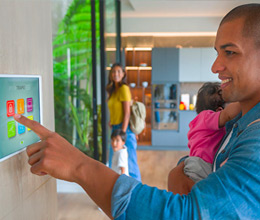What is a home security system?
A smart home security system is ready to arm and protect your customer's home, apartment or property from outside threats with the help of several connected network devices. Some of these devices include intrusion alarms, garage door openers, smart security cameras, video doorbells and much more. A security system also gives your customers around-the-clock protection with the help of professional installation. That way if they miss an intrusion alert, the installed security features can alert the authorities. Here are a few steps you need to check off your list before you install a home security system for your customers:
Check the size and type of home
Before you start purchasing your low-voltage equipment, you should check what type of residence it is. Is it a house or an apartment? Ideally, apartments require fewer smart gadgets to install due to being a smaller area. A large home will require much more equipment versus a small apartment, which uses less space. That is why it is imperative to know which type of security solutions you will need to properly install your next home security system.
What security equipment will you need?
Knowing your customer's security equipment needs for their home (How big is the home? What security equipment will they need and for what? How old is the property?) can make the installation process easier to manage. Low-voltage security equipment acts as the bridge for communicating to the base station in the home, meaning that the connected devices are able to send signals to alert the customer of a possible security breach. There are a wide variety of categories that these security sensors fall into, including fire, networking, access control and intrusion. Here are some of the basic types of low-voltage equipment that should come with a home security installation:
- Smart security cameras – Smart security cameras offer more viewing range of the home with a fish-eye lens so homeowners can keep track of any activity after receiving safety alerts.
- Motion detectors – Motion detectors act as an extra guard to detect any movement which then sends signals to the alarms – alerting the homeowner. There are different types of motion sensors. The most common ones are passive infrared (PIR), Microwave (MW) and dual technology motion sensors. PIR sensors can detect body heat and movement coming from an intruder. A MW sensor can detect a moving object's shadow or reflection. A dual technology sensor is a combination of two motion sensors that help eliminate false alarms.
- Video doorbells – These smart devices let the homeowner view any suspicious activities on their porch from virtually anywhere.
- Keypads – This device will let the homeowner set up a numeral code that can arm and disarm the security system.
- Key fobs – These remote-control devices let users arm and disarm their system remotely.
- Glass break sensors – This technology will alert and identify any detection of an intruder breaking or entering a glass window.
- Smoke detectors/CO detectors – These detection devices will help alert the homeowner of any smoke or carbon monoxide in the room.
- Panic buttons – This technology can be installed anywhere and act as a "help" button to alert authorities in any medical emergency or home intrusion.
How will the home be managed?
There are many ways to manage a home security system. Your customers can choose from keypads, control panels, voice control or a mobile app to manage their home security system with ease. These management systems or base stations are programmed to alert, disarm and display security footage at the homeowner's discretion. In addition, these security options serve to connect wirelessly to each smart home device and the internet.
Managing a home using a voice-activated system is an increasingly popular feature. A voice assistant (such as Google Assistant and Amazon Alexa) can turn lights on and off, disarm a motion sensor and more by just using the homeowner's voice.
Control panels and keypads are common control systems used in most homes that help arm and disarm equipment, such as door locks, alarm systems and other smart home controls.
Mobile security apps are perfect for keeping an eye on the home or apartment when the homeowner is away, all from the touch of their mobile device. Homeowners can easily access security cameras, alarms and other smart home devices whenever it is convenient for them.
Landline, broadband or cellular?
We know that a reliable network connection is essential for home security equipment. But which network connection is the best choice for your customer? You can choose from landline, broadband or cellular.
A landline is a wired network that requires a telephone and radio frequency that is professionally installed in the home. A landline is traditionally cheaper than a wireless connection and it is more reliable when an internet connection is not available.
Broadband is a wireless option that more and more homeowners are using. If a homeowner has high-speed internet, a broadband connection is the right choice. Even with this choice, customers should have backup batteries in case the internet connection is lost.
A cellular or Wi-Fi network is used to communicate easily via a smartphone app that can control the devices. This method will require a chip to be installed in order to notify the security system.
Conclusion
A home security system offers protection for your customer's family and home. Knowing the different options and features will help you guide your customers to make the right decision for them. And, by becoming an expert in these technologies, you can offer 24/7 professional monitoring that will keep your RMR increasing and keep your customers safe whenever they need it.


